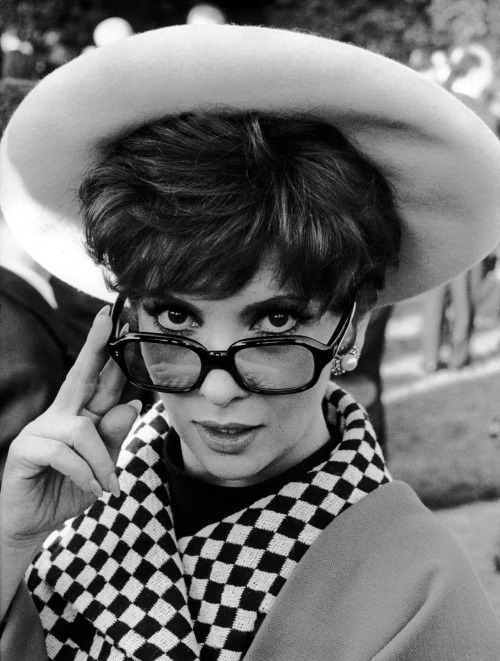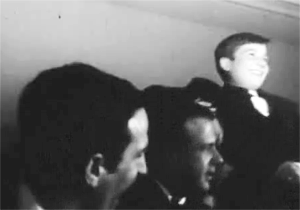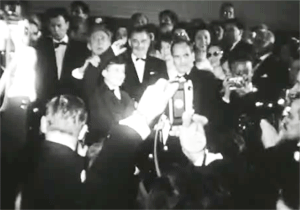
Hipster Lollobrigida (via HardyAndNelson)
A mini-fest of movies about soccer rivalries before the Portland Timbers play one of the biggest rivalry matches of the year.






Triomphe: Jean-Pierre Léaud and François Truffaut at the 1959 Cannes Film Festival (via MabelLonghetti)
The curator of a Northwest Film Center crime film series talks about the hardboiled Hollywood movies he loves.
Reviews of this week's new releases in Portland-area theaters.
Not a lot of new stuff this weekend, as movie distributors try not to get their opening weekends blitzed by the dawn of a new NFL seasons. We have a handful of reviews: a comparison of two fascinating documentaries, "Samsara" and "The Ambassador"; a look at Spike Lee's back-to-the-old-neighborhood picture "Red Hook Summer"; and a slam of the inane literary drama "The Words." And, eternally, "Also Opening," "Indie/ArtHouse," "Levy's High Five" and (under the old name that it once again sports) "Retro-a-Gogo."
This guy. I remember this guy.
The five films playing in Portland-area theaters that I'd soonest see again.
1) "Beasts of the Southern Wild" A dreamy and joyous film about life, death, hope, dreams and wonder on an island in the Mississippi Delta. The miraculous young Quevezhané Wallis stars as Hushpuppy, a wee girl who experiences life in the feral community known as the Bathtub as a stream of wonder and delight, even though her dad (Dwight Henry) is gruff, her mom is absent and a killer storm is bearing down on her home. Writer-director Behn Zeitlin, in his feature debut, combines poetry and audacity in ways that recall Terrence Malick, but with a light and spry touch. Still, all his great work pales in comparison to the stupendous little Wallis, whom you'll never forget. Hollywood, Living Room
2) "Moonrise Kingdom" Wes Anderson films are such a specific taste that I'm a bit hesitant to suggest that this might be his most approachable (but surely not crowd-pleasing) work. In the wake of the delightful "The Fantastic Mr. Fox," Anderson returns to live-action and his familiar tics and habits in a tale of young (as in 'pre-teen') lovers on the run. Newcomers Jared Gilman and Kara Hayward fill the lead roles delightfully, and Anderson's muses Bill Murray and Jason Schwartzman are joined ably by Edward Norton, Bruce Willis and Frances McDormand, among others. It's a light and breezy film with a very sweet heart and old-fashioned sturdiness. Even if you were left puzzled by the likes of "Rushmore" or "The Royal Tenenbaums" (still his best non-animated films, for me), this is likely to win you over. Cine Magic, Fox Tower, St Johns
3) "The Bourne Legacy" A dense, slick and thrilling spy movie that's got as much brain power as brawn. Writer-director Tony Gilroy ("Michael Clayton") turns the trilogy of films about Jason Bourne into the story of Aaron Cross (Jeremy Renner), another souped-up intelligence operative on the run from the secretive organizations which built him. The film cleverly integrates the story of the previous three, but stands alone as a gripping story about a man trying to extend the only life that he has come to know and depending on a geneticist (Rachel Weisz) and his own abilities to stay alive. From the complex narrative to the thrilling final half-hour, it's top shelf stuff. multiple locations
5) "Robot & Frank" Frank Langella is a delight in a film about a curmudgeonly retiree whose children foist a robot on him to monitor his diet, activities and housework. The grumpy old fella hates the little electronic buddy (whose voice is provided by Peter Sarsgaard), then he realizes he has a use for it: he devises a means to use it to get back into his life's work, which happens to be burglary. Debuting director Jake Schreier and screenwriter Christopher D. Ford nicely balance the mild sci-fi with human comedy, and a sharp supporting cast, which includes Susan Sarandon, James Marsden and Liv Tyler, give the great Langella all the room he needs to be wonderful. Fox Tower
Two documentaries of diverse style and aims show what can happen when first-world filmmakers take a look at other cultures.
A story about a novel about a novel should have been erased from the word processor, not made into a film.
A film meant to evoke "Do the Right Thing" is more muddled than powerful.
In the 23 (!) years since the fiery summer's day of "Do the Right Thing," Spike Lee has had some moments of glory ("Malcolm X," "Inside Man," "4 Little Girls") and inspiration ("Crooklyn," "Clockers," "25th Hour"), but he's never been able to capture the same power, pop energy, passion and polemic force as in that epochal film.
To see his newest work, "Red Hook Summer," is too see how far Lee is from his impressive best. A companion, of sorts, to "Right Thing," the film takes place in another Brooklyn summer, with young Flik (Jules Brown) dropped by his Georgia-based mom to live for a few months with her dad, Enoch (Clarke Peters), a storefront preacher and boiler repairman in the local housing projects.
It's something of a coming-of-age story, with Flik learning the harsh ropes of big city life alongside an almost-sweetheart (Toni Lysaith) and avoiding the neighborhood tough guys (led by Nate Parker). Mookie the pizza man (Lee himself) makes an appearance (illogically still delivering pies on foot from Sal's Famous, which is nowhere near Red Hook), and there are other diversions, both filmic and narrative which sometimes engage but more often eat up time frustratingly.
The highlights, without question, are Bishop Enoch's fiery, musical, galvanizing sermons, which dot the story and are implicated with a sensationalist turn in its final portion. Peters ("The Wire") is superb in these scenes, without which "Red Hook Summer" would be a vague and somewhat desperate attempt to rekindle past promises. Lee is, as ever, a gifted image-maker, but his storytelling has gotten so lax over time as to barely register. This isn't the "Right Thing" in any sense.
(121 min., R, Hollywood Theatre) Grade: C-plus

Lads: JFK and FAS at the DNC, 1960 (via HumphreysBogart)
The comedian/filmmaker will barnstorm Portland on Saturday.

“If she asks, tell her you served two terms….”
New releases in Portland-area theaters not reviewed in this week's A&E.
“Amateurs and Auteurs" A selection of homemade narrative films curated by local film archivist and artist Ian Sundahl. (Hollywood Theatre, Tuesday only)New releases in Portland-area theaters not reviewed in this week's A&E.
“Amateurs and Auteurs" A selection of homemade narrative films curated by local film archivist and artist Ian Sundahl. (Hollywood Theatre, Tuesday only)Catch 'em while you can!
You could make a couple of thoughtful double-features out of the films that are departing local theaters after Thursday night -- which, conveniently, gives you enough time to do just that. The titles to catch up with are "Ai WeiWei: Never Sorry," a documentary about the Chinese activist and artist; "Oslo, August 31," an intelligent drama about a recovering drug addict revisiting his old life; "Cosmopolis," David Cronenberg's ambitious adaptation of a Don DeLillo novel about a financier with his life in ruins; and "360," a multi-character drama starring Jude Law, Rachel Weisz, and Anthony Hopkins.Everything old is new again!
"Batman" Tim Burton's 1989 revival of the Caped Crusader, with Michael Keaton beneath the mask, Jack Nicholson chewing the scenery as the Joker, and Cort and Fatboy presenting. (Bagdad Theater, Friday only)© 2025 Shawn Levy Dot Com
Theme by Anders Noren — Up ↑